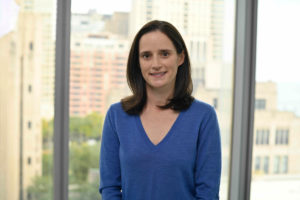
Northwestern Medicine investigators have discovered a novel mechanism that connects circadian rhythm-controlled cellular metabolism and regeneration with muscle repair after injury, according to recent findings published in the journal Genes and Development.
Clara Peek, PhD, assistant professor of Biochemistry and Molecular Genetics, was senior author of the study.
Disruptions in circadian rhythm — the body’s internal 24-hour clock that regulates rest and wakefulness — have been associated with the pathogenesis of different metabolic disorders, including diabetes and obesity. However, research regarding its association with tissue regeneration and muscle repair has remained limited.
In the current study, Peek’s team investigated the role of adult muscle stem cell’s circadian clock in controlling muscle regeneration and tissue repair after acute ischemic injury in mice. They zeroed in on the protein Bmal1 — a circadian clock regulator protein expressed in virtually all cells in the body — and aimed to identify its exact role within muscle stem cells and greater muscle repair.
“Bmal1 controls rhythms of gene expression, including those involved in regulating sleep, activity, hormones and metabolism. It had been shown to be important for proliferation and muscle repair, but the molecular mechanism was not identified,” said Peek, who is also an assistant professor of Medicine in the Division of Endocrinology, Metabolism and Molecular Medicine and a member of the Robert H. Lurie Comprehensive Cancer Center of Northwestern University.
Peek and her team found that muscle repair after injury was greater when mice were active or awake compared to when they were inactive or resting. Additionally, the loss of the protein Bmal1 within the muscle stem cells led to impaired muscle regeneration.
Using metabolomic profiling to study approximately 10,000 activated muscle stem cells in vivo and cultured myoblast cells, or premature muscle cells, the investigators demonstrated that the loss of Bmal1 reduced the amount of activated muscle stem cells on the third day after injury.
Furthermore, loss of Bmal1 impaired the response of muscle stem cells to hypoxia — insufficient oxygen in tissues to sustain proper bodily function — that occurs after injury. The loss of Bmal1 in also led to reduced glycolysis, or a decrease in energy generated by the cells.
Finally, investigators discovered that increasing NAD+ — a coenzyme essential for all metabolic processes in the body — in Bmal1-deficient myoblasts restored both muscle stem cell proliferation and myofiber formation.
“Our finding that restoring the redox metabolite, NAD+, to clock-disrupted stem cells can restore normal proliferation and muscle fiber formation is exciting because it suggests that NAD+ restoration can counteract the effects of muscle injury at the ‘wrong’ time of day, during normal resting hours,” Peek said.
Peek said her team is now interested in studying the impact of the muscle stem cell circadian clock and NAD+ regulation in muscle repair and growth following exercise, as well as the importance of the muscle stem cell clock in muscle repair during aging.
Navdeep Chandel, PhD, the David W. Cugell, MD, Professor of Medicine in the Division of Pulmonary and Critical Care and a professor of Biochemistry and Molecular Genetics, was a co-author of the study.
This work was supported by the National Institutes of Health National Institute of Diabetes and Digestive and Kidney Diseases grant R01DK123358, National Cancer Institute grant R35CA197532 and National Institute on Aging grant P01AG049665.






